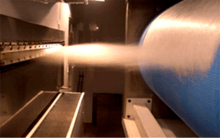Melt blowing
Melt blowing is a conventional fabrication method of micro- and nanofibers where a polymer melt is extruded through small nozzles surrounded by high speed blowing gas. The randomly deposited fibers form a nonwoven sheet product applicable for filtration, sorbents, apparels and drug delivery systems. The substantial benefits of melt blowing are simplicity, high specific productivity and solvent-free operation. Choosing an appropriate combination of polymers with optimized rheological and surface properties, scientists have been able to produce melt-blown fibers with an average diameter as small as 36 nm.[1]

History
During volcanic activity a fibrous material may be drawn by vigorous wind from molten basaltic magma called Pele's hair.[2] The same phenomenon applies for melt blowing of polymers. The first research on melt blowing was a naval attempt in the US to produce fine filtration materials for radiation measurements on drone aircraft in the 1950s.[3] Later on, Exxon Corporation developed the first industrial process based on the melt blowing principle with high throughput levels.[4] China produces 40% of the non-woven fabric in the world with the majority produced in Hebei province (2018).[5]
Polymers
Polymers with thermoplastic behavior are applicable for melt blowing. The main polymer types commonly processed with melt blowing:[6]
Uses
The main uses of melt-blown nonwovens and other innovative approaches are as follows.[7]
Filtration
Nonwoven melt-blown fabrics are porous. As a result, they can filter liquids and gases. Their applications include water treatment, masks, and air-conditioning filters.
Sorbents
Nonwoven materials can retain liquids several times their own weight. Thus, those made from polypropylene are ideal for collecting oil contamination.[8][9]
Hygiene products
The high absorption of melt-blown fabrics is exploited in disposable diapers and feminine hygiene products.[10]
Apparels
Melt-blown fabrics have three qualities that help make them useful for clothing, especially in harsh environments: thermal insulation, relative moisture resistance and breathability.
Drug delivery
Melt blowing can produce drug-loaded fibers for controlled drug delivery.[11] The high drug throughput rate (extrusion feeding), solvent-free operation and increased surface area of the product make melt blowing a promising new formulation technique.[12]
References
- Soltani, Iman, and Macosko, Chrisotpher W. (2018). "Influence of rheology and surface properties on morphology of nanofibers derived from islands-in-the-sea meltblown nonwovens". Polymer. 145: 21–30. doi:10.1016/j.polymer.2018.04.051.CS1 maint: uses authors parameter (link)
- Shimozuru, D. (1994). "Physical parameters governing the formation of Pele's hair and tears". Bulletin of Volcanology. 56 (3): 217–219. Bibcode:1994BVol...56..217S. doi:10.1007/s004450050030.
- Shaumbaugh, R.L. (1988). "A macroscopic view of the melt-blowing process for producing microfibers". Ind. Eng. Chem. Res. 27 (12): 2363–2372. doi:10.1021/ie00084a021.
- Ellison CJ, Phatak A, Giles DW, Macosko CW, Bates FS (2007). "Melt blown nanofibers: Fiber diameter distributions and onset of fiber breakup". Polymer. 48 (11): 3306–3316. doi:10.1016/j.polymer.2007.04.005.
- "China export credit insurance company releases domestic mask supply and demand risk analysis and outlook". Textile Net China. February 17, 2020.
- Dutton, Kathryn C. (2008). "Overview and analysis of the meltblown process and parameters". Journal of Textile and Apparel, Technology and Management. 6.
- McCulloch, John G. (1999). "The history of the development of melt blowing technology". International Nonwovens Journal. 8: 1558925099OS–80. doi:10.1177/1558925099os-800123.
- Wei, Q. F.; Mather, R. R.; Fotheringham, A. F. & Yang, R. D. (2003). "Evaluation of nonwoven polypropylene oil sorbents in marine oil-spill recovery". Marine Pollution Bulletin. 46 (6): 780–783. doi:10.1016/s0025-326x(03)00042-0. PMID 12787586.
- Sarbatly R.; Kamin, Z. & Krishnaiah D. (2016). "A review of polymer nanofibres by electrospinning and their application in oil-water separation for cleaning up marine oil spills". Marine Pollution Bulletin. 106 (1–2): 8–16. doi:10.1016/j.marpolbul.2016.03.037. PMID 27016959.
- Wehmann, Michael; McCulloch, W. John G. (2012). "Melt blowing technology". In Karger-Kocsis, J. (ed.). Polypropylene: an A-Z reference. Springer Science & Business Media. doi:10.1007/978-94-011-4421-6_58.
- Balogh, A.; Farkas, B.; Faragó, K.; Farkas, A.; Wagner, I.; Van Assche, I.; et al. (2015). "Melt‐blown and electrospun drug‐loaded polymer fiber mats for dissolution enhancement: A comparative study". Journal of Pharmaceutical Sciences. 104 (5): 1767–1776. doi:10.1002/jps.24399. PMID 25761776.
- QDevelopment. "Melt blowing". Retrieved 1 June 2016.